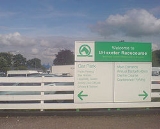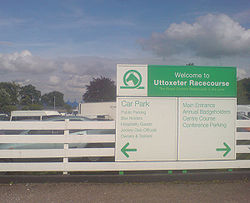
Uttoxeter Racecourse
Encyclopedia
Uttoxeter Racecourse is a National Hunt racecourse in the town of Uttoxeter
, in Staffordshire
, England
.
 Uttoxeter is a left-handed oval shaped course of one mile two and a half furlongs in circumference.
Uttoxeter is a left-handed oval shaped course of one mile two and a half furlongs in circumference.
The back ‘straight’ has a dog-leg to the right and is undulating as it rises over Clump Hill. The course continues with a downhill run around the far bend into the home straight.
The home straight of four furlongs is flat and galloping ensuring fair and competitive finishes to most races including the signature staying chases. The nature of the track often enables front-running tactics to pay off.
Dating back to the early 1900s Uttoxeter has raced through some of the most important historic events of the last Millennium.
1907 The racecourse was built and opened by a company formed to take over the interests and licence of Keele Park racecourse, which had recently ceased to operate. There were 5 days of racing in 1907, 2 in May, 2 in October and 1 in December. According to 'The Racecourse of Great Britain and Ireland' guide "the meeting is largely patronised by the nobility and gentry and sportsmen in the county there being 100 members already subscribed to the Club".
1914 The First World War closed down all racing throughout the country.
1921 Racing was resumed, although the first meeting had to be abandoned on account of bad weather. 4 meetings a year were held, in April, May, September and October, and although the course never broke records, there were always good fields, big crowds, and a small but steady profit for the Racecourse Company.
1945 During the Second World War the course was requisitioned by the War Department and no racing, of course, took place.
1949 The Uttoxeter Urban Council appoints a committee to investigate the non-resumption of racing after the war. Part of the course consisted of a four-acre field which the Racecourse Company did not own, but only leased from a farmer, who was reluctant to lease or sell it to them at a sum which they could afford. It appeared the company would have to go into liquidation and the racecourse would disappear.
1952 After much debate, the racecourse re-opened on April 12, 1952. With a crowd of 12,000, the meeting was so successful that the organisers were almost overwhelmed. The Uttoxeter Urban Council had come to the rescue of the course and their decision to buy it was upheld by the community.
1966 Popular, but without the funds to modernise and rebuild as the Executive would have wished, in 1966 the course took its place in the modernisation lists of the Horserace Betting Levy Board. A scheme was drawn up and approved whereby £167,000 would be spent in giving the course its long overdue facelift.
1967 Champion jockey Josh Gifford equalled Fred Winter's record of 121 winners in a season at Uttoxeter on June 15, the very last meeting of the 1966-67 National Hunt term. The horse was five-year-old Jolly Signal trained by Earl Jones at Hednesford. Half an hour later Gifford broke the record when he rode Red Flush to a 10-lengths victory in the Ashbourne Handicap Chase.
1976 Rag Trade, owned by the flamboyant hairdresser Raymond 'Teasy Weasy' Bessone
, won the Marston's Pedigree Midlands Grand National and followed-up by winning the Grand National at Aintree a year later.
1982 Uttoxeter was again the decisive venue when John Francome, on John Edward's Buckmaster, gained his 800th overall winner and his 120th for the season to share the jump jockeys title with the sidelined Peter Scudamore.
1988 Northern Racing acquires the course with Sir Stanley Clarke as Chairman. Northern Racing made a significant investment in facilities, including the creation of two new grandstands and a new paddock development.
1997 The Midlands National produced its most famous horse in Lord Gyllene, owned by Uttoxeter's Chairman Sir Stanley Clarke. Lord Gyllene finished second to Seven Towers in the race but four weeks later recorded an historic victory in the Grand National at Aintree. His winning margin of 25 lengths was the most impressive in 20 years and he also recorded one of the fastest times in the race's history.
2002 History is made when Champion jockey Tony McCoy became the winning-most National Hunt jockey of all time with his victory aboard Mighty Montefalco, marking his 1700th win.
Uttoxeter
Uttoxeter is a historic market town in Staffordshire, in the West Midlands region of England. The current population is approximately 13,711, though new developments in the town will increase this figure. Uttoxeter lies close to the River Dove and is near the cities of Stoke-on-Trent, Derby and...
, in Staffordshire
Staffordshire
Staffordshire is a landlocked county in the West Midlands region of England. For Eurostat purposes, the county is a NUTS 3 region and is one of four counties or unitary districts that comprise the "Shropshire and Staffordshire" NUTS 2 region. Part of the National Forest lies within its borders...
, England
England
England is a country that is part of the United Kingdom. It shares land borders with Scotland to the north and Wales to the west; the Irish Sea is to the north west, the Celtic Sea to the south west, with the North Sea to the east and the English Channel to the south separating it from continental...
.

The back ‘straight’ has a dog-leg to the right and is undulating as it rises over Clump Hill. The course continues with a downhill run around the far bend into the home straight.
The home straight of four furlongs is flat and galloping ensuring fair and competitive finishes to most races including the signature staying chases. The nature of the track often enables front-running tactics to pay off.
Dating back to the early 1900s Uttoxeter has raced through some of the most important historic events of the last Millennium.
1907 The racecourse was built and opened by a company formed to take over the interests and licence of Keele Park racecourse, which had recently ceased to operate. There were 5 days of racing in 1907, 2 in May, 2 in October and 1 in December. According to 'The Racecourse of Great Britain and Ireland' guide "the meeting is largely patronised by the nobility and gentry and sportsmen in the county there being 100 members already subscribed to the Club".
1914 The First World War closed down all racing throughout the country.
1921 Racing was resumed, although the first meeting had to be abandoned on account of bad weather. 4 meetings a year were held, in April, May, September and October, and although the course never broke records, there were always good fields, big crowds, and a small but steady profit for the Racecourse Company.
1945 During the Second World War the course was requisitioned by the War Department and no racing, of course, took place.
1949 The Uttoxeter Urban Council appoints a committee to investigate the non-resumption of racing after the war. Part of the course consisted of a four-acre field which the Racecourse Company did not own, but only leased from a farmer, who was reluctant to lease or sell it to them at a sum which they could afford. It appeared the company would have to go into liquidation and the racecourse would disappear.
1952 After much debate, the racecourse re-opened on April 12, 1952. With a crowd of 12,000, the meeting was so successful that the organisers were almost overwhelmed. The Uttoxeter Urban Council had come to the rescue of the course and their decision to buy it was upheld by the community.
1966 Popular, but without the funds to modernise and rebuild as the Executive would have wished, in 1966 the course took its place in the modernisation lists of the Horserace Betting Levy Board. A scheme was drawn up and approved whereby £167,000 would be spent in giving the course its long overdue facelift.
1967 Champion jockey Josh Gifford equalled Fred Winter's record of 121 winners in a season at Uttoxeter on June 15, the very last meeting of the 1966-67 National Hunt term. The horse was five-year-old Jolly Signal trained by Earl Jones at Hednesford. Half an hour later Gifford broke the record when he rode Red Flush to a 10-lengths victory in the Ashbourne Handicap Chase.
1976 Rag Trade, owned by the flamboyant hairdresser Raymond 'Teasy Weasy' Bessone
Raymond Bessone
Raymond Bessone , was a British hairdresser of the 1950s and 1960s.-Personal life:...
, won the Marston's Pedigree Midlands Grand National and followed-up by winning the Grand National at Aintree a year later.
1982 Uttoxeter was again the decisive venue when John Francome, on John Edward's Buckmaster, gained his 800th overall winner and his 120th for the season to share the jump jockeys title with the sidelined Peter Scudamore.
1988 Northern Racing acquires the course with Sir Stanley Clarke as Chairman. Northern Racing made a significant investment in facilities, including the creation of two new grandstands and a new paddock development.
1997 The Midlands National produced its most famous horse in Lord Gyllene, owned by Uttoxeter's Chairman Sir Stanley Clarke. Lord Gyllene finished second to Seven Towers in the race but four weeks later recorded an historic victory in the Grand National at Aintree. His winning margin of 25 lengths was the most impressive in 20 years and he also recorded one of the fastest times in the race's history.
2002 History is made when Champion jockey Tony McCoy became the winning-most National Hunt jockey of all time with his victory aboard Mighty Montefalco, marking his 1700th win.
Notable races
- Midlands Grand National Chase Handicap
- English Summer National Handicap Chase

